BY DAVE BAILEY
How we approach each structural fire depends on numerous variables. Routinely, our approach is a model based on Lloyd Layman’s seven fundamental steps of firefighting (size-up, call for help, rescue, cover exposures, locate the fire, control the fire, and overhaul) such as rescue, exposures, confinement, extinguishment, and overhaul (RECEO). Using a model, the incident commander (IC) considers the building or buildings impacted, the contents burning, the location and size of the fire, the exposures, the environmental variables, and the life hazard. The IC combines these variables to provide situational awareness of the incident and then factors in resource realities with the situational awareness to quickly create and implement a plan to manage the fire. This plan must include a quick risk/benefit analysis. In reality, the plan implemented is most often based on past practices of the local department and what has worked well for that IC in the past.
THE THREE STRUCTURAL FIRE PHASES
Actually, most of our planning only covers the first phase of a structural fire. When we “whiteboard” building fire incidents or discuss them in the parking lots of our district buildings, we routinely only plan for the initial attack with some support details (how and where to vent, for example). The first phase of a structure fire is by far the most challenging and is the one we prep for the hardest: the time between dispatch and whenever it is declared “under control.” For complex incidents, Phase 1 may encompass several subphases. Complexities such as multiple buildings on fire, large defensive operations, and firefighter Maydays will lengthen Phase 1’s routine time frame. Below, a routine Phase 1 is assumed.
To professionally manage fires and to keep our members safe, each IC needs to plan for and manage all phases of the incident. Phase 2 runs from when the fire is under control until you begin a controlled, planned building overhaul. Our progress in knowledge and technology has increased the importance of this phase and time frame. Phase 3 includes fire investigation, salvage, complete overhaul, and final pickup of all resources. Phases 2 and 3 are critical and must be planned for and well managed.
Since so much is written about Phases 1 and 3, we appropriately spend much time preparing for them. This article focuses on Phase 2. However, I review all phases to show the relationships among them and the importance of each. Although Phases 2 and 3 should be less dangerous than Phase 1, members continue to be injured and killed during all phases of structural fires. The phases of a structural fire are detailed below. Each phase has general objectives and tasks that you need to plan for and manage.
Phase 1: From Dispatch to “Under Control.” “Under control” means that the fire will damage no more of the structure, but smoldering and overhaul may continue long after this point. Phase 1 presents the highest number of hazards to firefighting crews. It includes the dangerous tasks of forcible entry, search and rescue, and interior firefighting; we spend most of our time preparing for this phase. We train well on the tasks to be performed and emphasize to all officers how to size up conditions to make safe effective decisions. Our members take the most risks in this phase of structural firefighting. During this phase, if we act wisely and decisively, lives and buildings can be saved.
The duration of Phase 1 varies greatly. If the initial crews enter the building, open a window, and put out the one trash can on fire, the incident will be under control within five minutes of entry time. In that case, the initial entry crews may be able to complete both Phase 1 and Phase 2 with only one air cylinder. More routinely, with working interior firefights, crews will go through one or more air cylinders to achieve under control. In these incidents, Phase 1 crew rotations and rehab along with continual crew accountability are extremely important.
This phase can be as short as 15 to 20 minutes (one air cylinder) to several hours of extensive firefighting. However, regardless of the incident, eventually the fire will be under control. Therefore, during Phase 1, the sharp IC will begin planning for Phase 2 and begin lining up resources to manage that phase. As the incident nears control, the IC or the plans section chief, if appointed, plans the demobilization of resources. It is critical at this point to understand well what you need in incident Phases 2 and 3 and how to conduct each safely (photo 1).
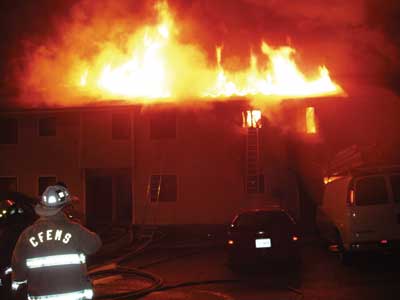 |
| (1) Photos courtesy of Chesterfield (VA) Fire and EMS. |
Phase 2: “Under Control” to Investigation/Overhaul. Once the fire is under control, we turn our efforts to identifying any hazards not yet realized, investigating the origin and cause of the fire, beginning or continuing salvage operations, and overhauling the fire to prevent a rekindle. In years past, with fire control achieved, all crews dropped their self-contained breathing apparatus (SCBA) and started overhaul. Breathing a little smoke was no big deal as long as your eyes weren’t burning so much that you couldn’t see. In that era, the sharp fire investigator went in quickly to ensure that overhaul actions did not destroy evidence. After fire control was achieved, the intense desire was to get cleaned up and back in service as soon as feasible. Of course, we now know this led to sloppy investigations and eventually to cancer.
Now with a better understanding of the hazards in this phase and of the benefits of good investigations to the community, we realize that this distinct phase has its own time frame. At offensive interior firefights, to complete our jobs safely and professionally, we no longer move straight from fire attack to complete overhaul. Consequently, the IC needs to prepare to manage this phase of the structural fire. Some view this phase of the incident as “babysitting the building” until overhaul crews are ready to complete the job. Actually, many important tasks must be accomplished in this phase for success. It is extremely important that all ICs and company officers understand what these tasks are and their respective importance.
Every fire department is a little different. In some, investigators respond to every working fire; in others, the IC conducts the investigation and only calls in special investigators if the cause is suspicious or cannot be determined. Still, some rural areas rely on outside investigators (state police, regional teams, and so on) and only call in an investigator on obvious arson fires. Regardless of who investigates the fire, you must conduct initial building overhaul without destroying evidence. The purpose of this minimal overhaul is to identify and mitigate hazards to make the building safe enough for the investigation. At fires managed with interior operations, you can usually accomplish this by avoiding destructive tasks in the area of fire origin. You can open up walls and ceilings remote from the area of origin to ensure that fire spread is halted. You will need to limit water use to prevent fire spread and to complete extinguishment in the fire area.
These initial limited overhaul tasks are conducted in conjunction with ventilation tactics, lighting the work area, and monitoring the atmosphere. You may need to correct or mitigate unsafe conditions to create a safe work area for investigators. This should include creating an atmosphere that is safe to work in without SCBA, establishing appropriate lighting, and identifying unsafe walking and working areas and correcting or barricading them. During Phase 2, salvage operations begun during Phase 1 will continue, or conditions and resources may allow initiation of beneficial salvage operations.
During Phase 2, the specific tasks that must be accomplished will vary according to the conditions at the point of under control. Using monitors, personnel must assess the atmosphere to determine the oxygen content and the presence of flammable gases, carbon monoxide, hydrogen cyanide, or any suspected toxin. Coordinated ventilation with electric fans will be needed to obtain and maintain a safe atmosphere, and supplemental lighting will be necessary to ensure safe walkways and work areas. This often will require that crews bring in portable lights with long cords. In this phase, void spaces are entered with hand tools and saws in conjunction with the appropriate water application equipment, and water will be applied to the fire area to quench smoke production. Finally, all types of salvage tactics may be employed during this phase (photos 2, 3).

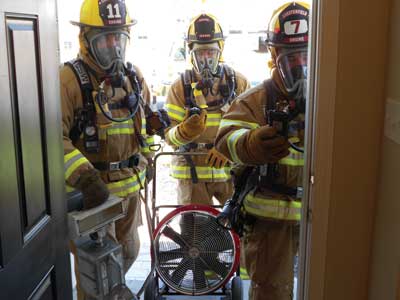
As Phase 2 is taking place, the IC should ensure that the crews that will work Phase 3 (investigation, overhaul, and final pickup) are preparing to do so. Bringing in fresh crews to conduct overhaul is a viable option for large departments and may be desirable for any size department if Phase 1 activities are grueling or if the environment is very hot or very cold. Unfortunately, fresh crews are not always possible. Regardless, the IC must orchestrate crew rotation to ensure crew safety (photo 4).
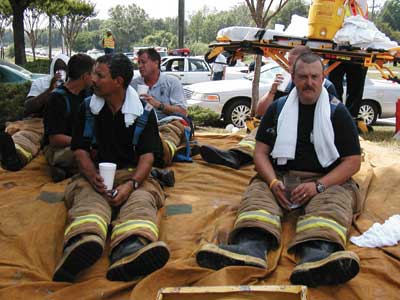
Phase 3: From Investigation/Overhaul to Return to Service. Investigators can conduct initial views of fire areas while wearing full turnout gear and SCBA. This is not optimal, and they cannot complete their investigative tasks effectively while so dressed. Therefore, Phase 3 actually begins as the building is free of identified major hazards and is made safe for entry without wearing SCBA. Many firefighters have been injured and killed conducting overhaul. To avoid this, develop a good overhaul plan prior to initiating investigation and overhaul tasks. Include a good safety analysis and safety briefing for all personnel before entry. To safely accomplish the overhaul job, choose the best crews for the job, fresh for the tasks to be completed (photo 5).
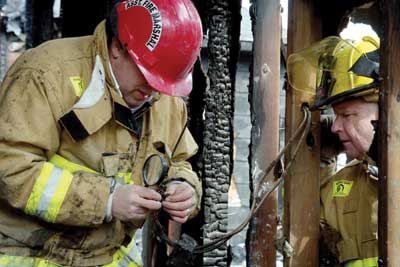
The competent IC will ensure this phase is accomplished safely and effectively through wisely forecasting task accomplishment during Phases 1 and 2. During those phases, the IC needs to predict which crews would best be used to conduct the overhaul of the structure. These crews will often be those first-in crews with apparatus committed to the scene with hoselines and equipment.
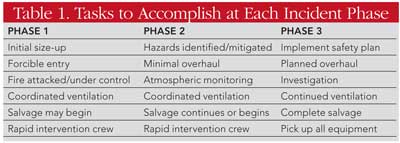
CREW DEPLOYMENT
How this phase concept affects crew deployment depends on the duration of Phase 1. For the fire that takes five minutes to bring under control, the first crews may be able to complete Phases 1 and 2 using only one air cylinder, take a quick break, and complete Phase 3 working with fire investigators or building occupants as appropriate. For fires involving a great amount of building contents or the entire structure, the first-in crews will consume one or more air cylinders and much energy bringing the fire under control. As the IC enters Phase 2, he needs to determine which crews will be conducting Phase 3 (overhaul and investigation). If the first-in crews are assigned to do overhaul, they must be rested; rehydrated; and, at times, fed well before Phase 3 begins (photo 6).

This brings a critical aspect of forecasting and coordination during Phase 2. The wise IC will make deliberate decisions to ensure Phase 3 crews are fresh and that Phase 2 crews understand the importance of the tasks they need to accomplish. If Phase 1 was strenuous, fresh crews will be needed to conduct Phase 2 work. The rapid intervention crew (RIC) is often fresh, so this may be one of the crews used to conduct Phase 2 tasks. If the initial RIC is used as a relief crew, an incoming crew or one of the initial attack crews will become the RIC as it emerges from rehab. Regardless of who conducts Phase 2 work, those crews must understand the important tasks they need to accomplish and prepare a safety briefing for the Phase 3 overhaul crews and investigators before leaving the scene.
We spend most of our time planning for Phase 1 of structural fires, so many officers are very good at managing the initial fire attack. As our understanding and technology are growing more sophisticated, we have the opportunity to work more safely and live longer than in the past. Wisely managing Phase 2 of structural fires will ensure we take advantage of this opportunity. To provide the best service to our public and to safely lead our firefighters, each IC and company officer must excel at planning and coordinating all phases of structural fires, including the in-between Phase 2.
DAVE BAILEY retired as a battalion chief with Chesterfield (VA) Fire and EMS after 35 years of service. He has an associate degree in police science, a bachelor’s degree in safety and risk administration, and a master’s degree in public administration. Bailey is a graduate of the National Fire Academy’s Executive Fire Officer program and the Federal Emergency Management Agency’s Advanced Professional Development for Emergency Managers program.
Fire Engineering Archives

